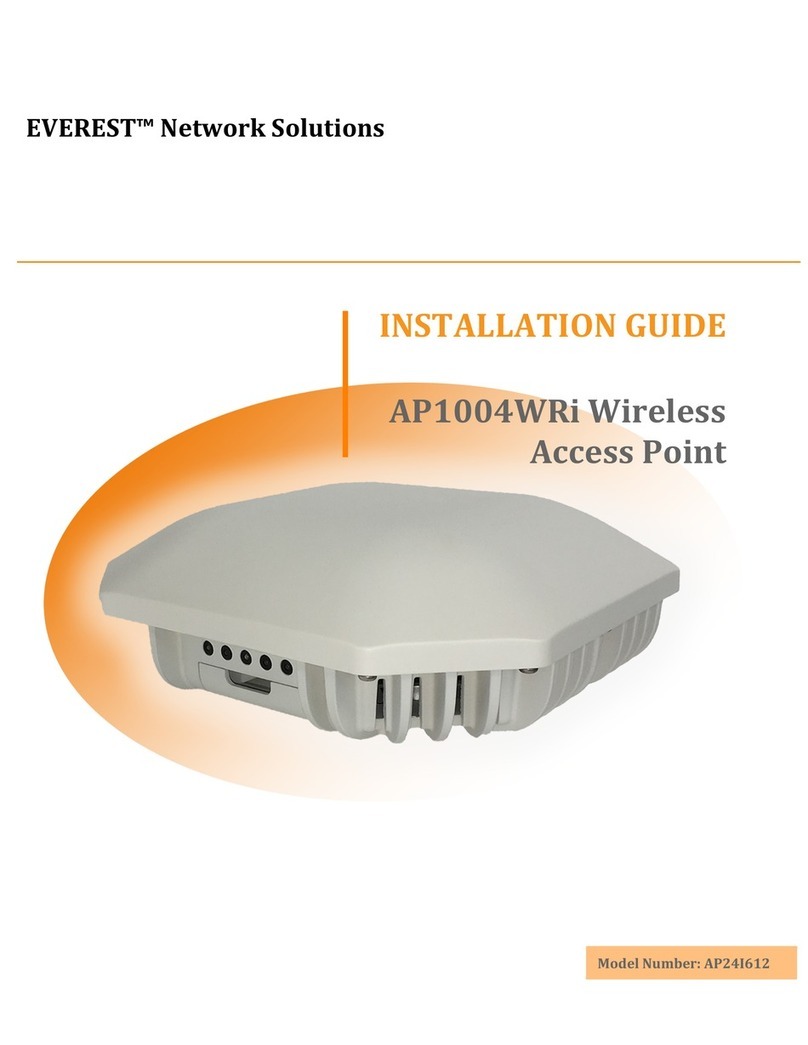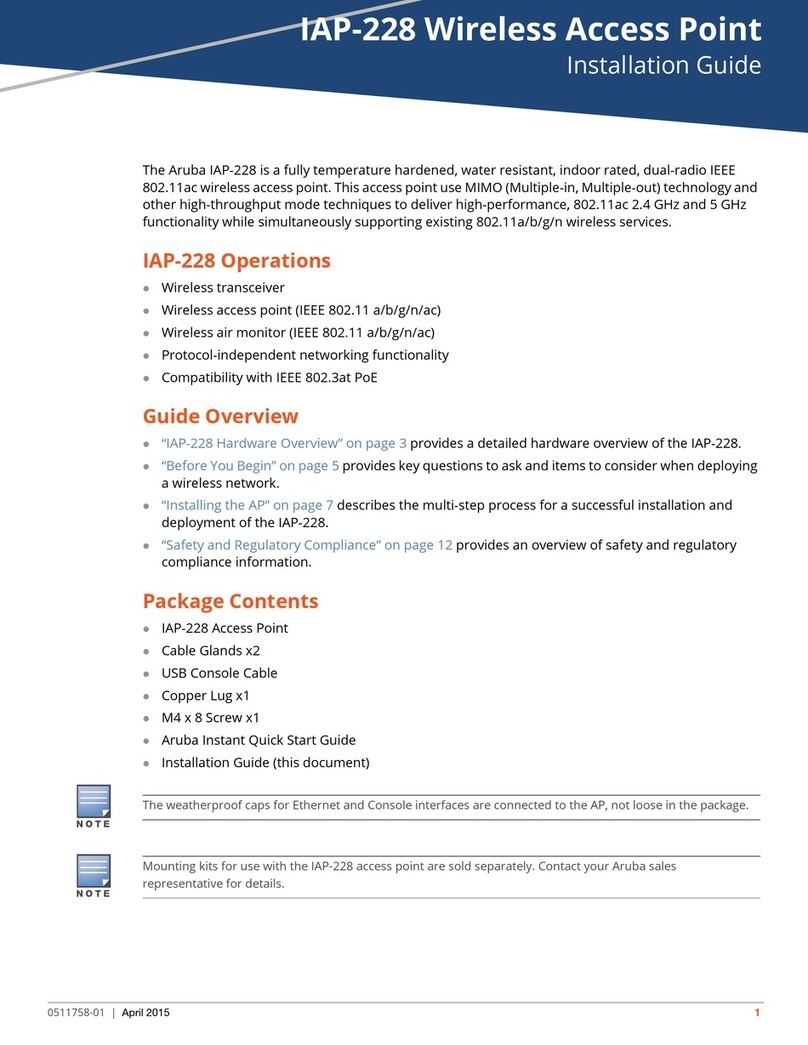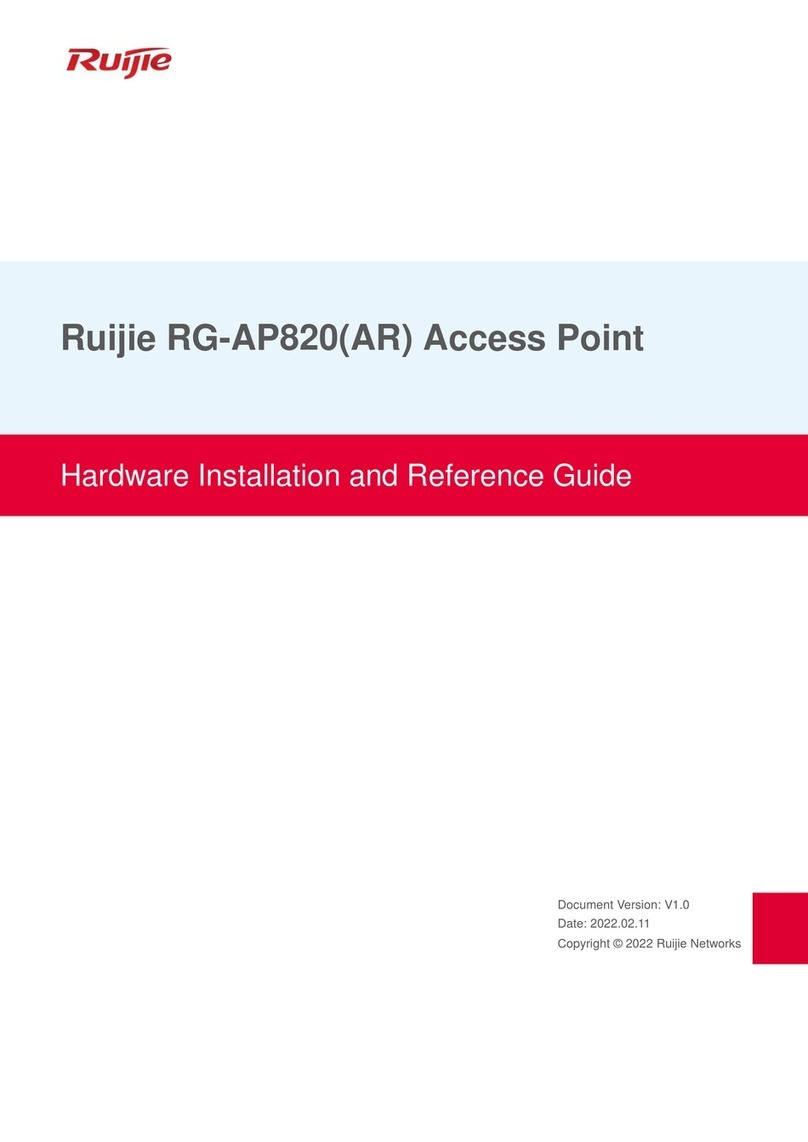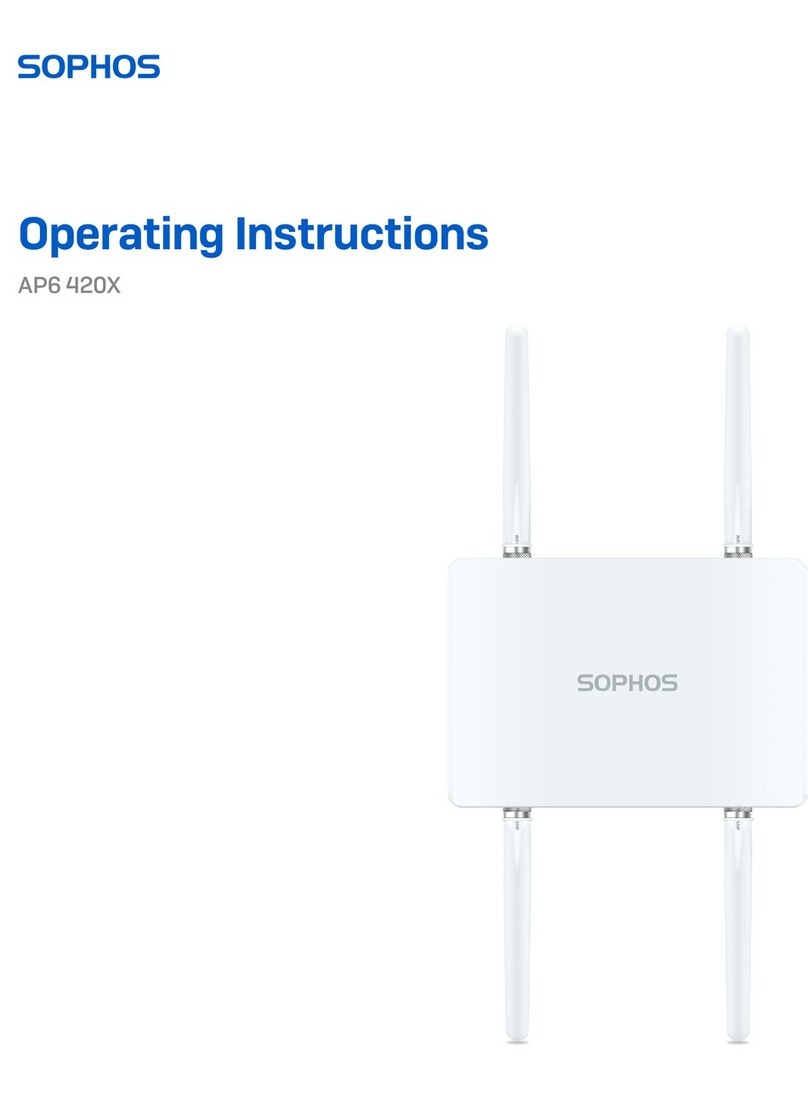Everest AP300 User manual

205 Ravendale Drive, Mountain View, CA 95054 (408) 300 9236 www.everestnetworks.com
!
INSTALLATION GUIDE
AP300
Wireless Access Point
Model Number: AP23I300
Release Number: 2.5.0

Page | 2
www.everestnetworks.com
INSTALLATION GUIDE
AP300
SAFETY WARNINGS ...................................................................................................................................... 1
General Safety ................................................................................................................................................................................... 1
Working Aloft Warning ...................................................................................................................................................................... 1
Lightning Activity Warning ................................................................................................................................................................ 1
Explosive Device Proximity Warning .................................................................................................................................................. 1
Antenna Placement Warning ............................................................................................................................................................. 1
Grounding Warning ........................................................................................................................................................................... 1
Power Installation Warning ............................................................................................................................................................... 1
Solar Irradiation and High Temperature Protection ........................................................................................................................... 1
OVERVIEW ................................................................................................................................................... 2
DEPENDENCIES ............................................................................................................................................................................................ 2
AP 1002 OI PACKAGE CONTENTS ................................................................................................................................................................... 2
ADDITIONAL ITEM ........................................................................................................................................................................................ 2
ITEM IDENTIFICATION .................................................................................................................................................................................... 3
RELATED DOCUMENTATION ............................................................................................................................................................................ 4
Access Point Installation Guides ...................................................................................................................................................... 4
Controllers Installation Guides ........................................................................................................................................................ 4
Systems User’s Guides .................................................................................................................................................................... 4
INSTALLING AP300 ....................................................................................................................................... 5
AP300 INSTALLATION USING MOUNTING BRACKET ............................................................................................................................................ 5
CONFIGURING AP300 ................................................................................................................................... 8
LOGGING INTO BASECAMP ............................................................................................................................................................................. 8
CONFIGURING AP300 .................................................................................................................................................................................. 8
Configuring the Country Code ............................................................................................................................................................ 9
Configurating the Operational Mode .............................................................................................................................................. 11
CONFIGURING AP300 TO WORK WITH DISCOVERY PROTOCOL ............................................................................................................................ 12
REGULATORY DECLARATIONS ..................................................................................................................... 13
FEDERAL COMMUNICATION COMMISSION (FCC) INTERFERENCE STATEMENT .......................................................................................................... 13
FCC RADIATION EXPOSURE STATEMENT: ........................................................................................................................................................ 14
EUROPEAN UNION (EU) INTERFERENCE STATEMENT: ......................................................................................................................................... 15
EUROPEAN UNION (EU) INTERFERENCE STATEMENT: ......................................................................................................................................... 15
EU RED ARTICLE 10 STATEMENT .................................................................................................................................................................. 15
EU RADIATION EXPOSURE STATEMENT: .......................................................................................................................................................... 15
TECHNICIAL SPECIFICATIONS ...................................................................................................................... 17
MECHANICAL SPECIFICATIONS ....................................................................................................................................................................... 17
LEDS ...................................................................................................................................................................................................... 17
OPERATIONAL REQUIREMENTS ...................................................................................................................................................................... 17
ENVIRONMENTAL REQUIREMENTS .................................................................................................................................................................. 18
RELIABILITY ............................................................................................................................................................................................... 18
PERFORMANCE .......................................................................................................................................................................................... 18
TRANSMIT POWER ..................................................................................................................................................................................... 19
STANDARDS .............................................................................................................................................................................................. 19
TABLE OF CONTENTS

Page | 1
www.everestnetworks.com
INSTALLATION GUIDE
AP300
The AP300 Wireless Access Point installation must be performed by certified technicians only
and in compliance with all local/state/federal safety requirements. All warnings and information in
this manual should be read and understood before proceeding with installation. Any noncompliance
by the installer or end user voids the warranty of the product.
General Safety
You can be killed or injured if performing antenna installation near electrical power lines.
Carefully read and follow all instructions in this guide. Ensure that there are no high voltage or
electrical fields nearby.
Working Aloft Warning
When working on tower or roof, individuals must wear safety belts. Tools must be tied to the
individual using them. Workers below must wear safety helmets.
Lightning Activity Warning
Make sure not to connect or disconnect cables during periods of lightning activity. A surge
protective device should be installed to prevent potential damage from very high surges, for
instance, the peak surges caused by lightning.
Explosive Device Proximity Warning
Do not operate network devices close to explosive merchandise or in explosive environments,
for example, in the vicinity of a gas station.
Antenna Placement Warning
Do not install any antenna near overhead power lines or other electric light, or where the
antenna can come into contact with such circuits.
Grounding Warning
Protect your AP300 Wireless Access Point by installation of grounding lines. The ground
connection must be complete before connecting power to the AP300 Wireless Access
Point
enclosure.
The
requirement
of
grounding
is
to
make
sure
the
resistance
is
less
than
5 ohms between
the ground termination point to grounding tier.
Power Installation Warning
The installation of the power switch must be performed by a certified technician. The power
switch is not supplied with the AP300 Wireless Access Point. The power cord must be assembled
by a certified technician, and the final assembly must comply with related requirements.
Solar Irradiation and High Temperature Protection
Pay attention to the level of sunlight, which can increase the working temperature of the
AP300 Wireless Access Point to higher than specifications allow.
SAFETY WARNINGS

Page | 2
www.everestnetworks.com
INSTALLATION GUIDE
AP300
OVERVIEW!
This document provides information and procedures required to install and configure the AP300
Wireless Access Point (model number AP23I300) into a WLAN installation and is intended for
certified system installers, system administrators, and network operators.
The WLAN system is designed for high density deployments. It comprises of the following main
components:
•
AP300 Wireless Access Point (AP)
•
Access Controller (AC)
•
BaseCamp™ Wireless Management System
Dependencies
The installation and configuration of AP300 Wireless Access Point depends on the following
components:
•
Access Controller
•
BaseCamp™ Wireless Management System
•
DHCP Server
AP 1002 Oi Package Contents
The AP300 package consists of the following items:
•
One AP300 Wireless Access Point
•
Ceiling Mount Adapter
•
Nylon Hollow Wall Anchors and Screws
Additional Item
The following items are to be purchased separately:
•
Access Controller
The BaseCamp™ Wireless Management System is bundled along with the Access Controller.
The installation technician is responsible for procuring additional wall/ceiling
anchors, mounting screws, and safety systems, as required by the
local/state/federal authorities governing the installation of the AP300 Wireless
Access Point.
CHAPTER ONE

Page | 3
www.everestnetworks.com
INSTALLATION GUIDE
AP300
Item Identification
The following figures show top and bottom view of the AP300 Wireless Access Point.
Figure 1: AP300 Wireless Access Point - Top View
Figure 2: AP300 Wireless Access Point - Bottom View
CHAPTER ONE

Page | 4
www.everestnetworks.com
INSTALLATION GUIDE
AP300
Related Documentation
Access Point Installation Guides
•
AP1004NRe Installation Guide.................................... DOC-000003
•
AP1004WRe Installation Guide ................................... DOC-000004
•
AP1002We Installation Guide ..................................... DOC-000005
•
AP1002Oi Installation Guide ....................................... DOC-000006
•
AP1004WRi Installation Guide .................................... DOC-000023
•
AP1004UNe Installation Guide ................................... DOC-000024
•
AP1004WRe-U Installation Guide............................... DOC-000025
•
AP300 Installation Guide............................................. DOC-000026
Controllers Installation Guides
•
Access Controller Configuration Guide ...................... DOC-000019
BaseCampTM Wireless LAN Management
•
BaseCamp™ System User Guide............................... DOC-000008
•
BaseCamp™ Quick Start Guide ................................. DOC-000017
CHAPTER ONE

Page | 5
www.everestnetworks.com
INSTALLATION GUIDE
AP300
INSTALLING AP300
This section provides information and procedures required to install the AP300 Wireless Access
Point using various methods.
AP300 Installation Using Mounting Bracket
Figure 3 on the next page shows how to mount the AP300 access point to a wall or ceiling, First,
if applicable, position the mounting plate in the desired location on the wall or ceiling so the network
cable aligns with one of the larger opening in the mounting plat.
The AP300 Wireless Access Point installation must be performed by
certified technicians only and in compliance with all local/state/federal safety
requirements and building codes.
Proper grounding and surge protectors may be required in outdoor
installations.
The network coverage depends on the location and position of the AP300
Wireless Access Point.
CHAPTER TWOCHAPTER TWO
Install the mounting plate with clips facing away from the wall or celling.
If mounting the AP300 on a wall, please insure that the orientation of the
bracket is correct so the Text on the AP300 is readable.

Page | 6
www.everestnetworks.com
INSTALLATION GUIDE
AP300
Figure 3: AP300 Mounting
Secure the mounting plate using the included drywall anchors and screws and connect the
network cable to the network LAN1 port of the access point.
CHAPTER TWO

Page | 7
www.everestnetworks.com
INSTALLATION GUIDE
AP300
Figure 4: Locking the AP300 to Mounting
Align the access point mounting holes with the mounting plate clips and rotate the access point
clockwise to lock into place.
Finally, install the cable guard by shield it onto the mounting plate until it locks into the plate.
CHAPTER TWO

Page | 8
www.everestnetworks.com
INSTALLATION GUIDE
AP300
CONFIGURING AP300
This section provides an overview of the basic procedures required to configure the AP300
Wireless Access Point. Please refer to the BaseCamptm User’s Guides for more details on
configurating access points and setting up more advanced deployment scenarios.
Logging into BaseCamp
Perform this procedure to log into BaseCamp.
Enter the BaseCamp URL, https://<AC IP address> in to the address window on your browser.
When the Everest BaseCamptm welcome screen is displayed, use the following credentials to log
in:
Password: admin
Configuring AP300
Perform this procedure to configure the AP300 Wireless Access Point.
Configure the PoE+ port of the L2/L3 switch as access ports with untagged PVID.
Only one Ethernet port is required for AP300 installation and operation.
For more information on configuring the AP300 Wireless Access Points that are connected to the
POE+ source that supports a discovery protocol, see Configuring AP300 to Work with Discovery
Protocol.
Connect the AP300 Access Point to a POE+ source.
Within about 90 seconds after the access point receives power, the AP300 Access Point will
requests an IP address from the DHCP server
Verify if the AP300 was assigned an IP address, by doing one of the following:
Review the DHCP logs on the DHCP server
Log into BaseCamp to review the status in the Access Points screen
When an AP is discovered, it will receive its own IP address and the IP Address of the Access
Controller. Once a secure connection has been established, the AP300 will be displayed in the
‘Access Point’ screen in the BaseCamptm Web Page. Figure 6 on the next page shows an example
of the information available on this screen.
CHAPTER THREE

Page | 9
www.everestnetworks.com
INSTALLATION GUIDE
AP300
Figure 5 - Everest BaseCamptm Access Point Screen
Configuring the Country Code
When a new AP300 access point is discovered by the Access Controller, the Country Code
stored in to the access point non-volatile memory will be the matched against the locked Country
Code of the controller before the access point is allowed to join the network and configured to
transmit.
When a generic Country Code is detected, which is the initial value programmed when the AP300
is manufactured, the Access Controller will register the AP300 by pushing the locked country code
from the Access Controller to the access point, where it is stored in non-volatile memory.
In every other case, when a mis-match is detected, the Access Controller will prevent the AP300
from joining the network. In this state the Access Point is considered ‘quarantined’ and will not be
configured or allowed to transmit.
The US & Canada are among the countries that restrict the end user’s
ability to modify the country code.
CHAPTER THREE

Page | 10
www.everestnetworks.com
INSTALLATION GUIDE
AP300
The following steps are performed by the Access Controller during the discover stage.
•
Step 1: If the country code registered in the non‐volatile memory of the AP300 and
the country code locked into the Access Controller software match, the AP300 is
allowed to join the network.
•
Step 2: If an AP300 is detected with a generic country code, the Access Controller
registers the AP300 by overwriting the generic country code with the locked
country code from the BaseCamp configuration. After updating the country code,
the AP300 is automatically rebooted allowing it to join the network.
•
Step 3: If the AP300 is set with a different country code, the AP300 is quarantined
and is not allowed to join the network as a functioning access point. The AP
Screen will continue to display the amber “Discovery” status for this access point
and it will be assigned an IP Address by the DHCP Server. The AP will be visible in
the Access Point list and status screen. However, any radio configurations will not
be pushed to the access point and it will be restricted from transmitting
The transmitters on the radio modules in the AP300 are disabled when the
country code is in the generic state, or when a mismatch is detected
between the registered country code on the AP300 and the locked country
code in the Access Controller
CHAPTER THREE

Page | 11
www.everestnetworks.com
INSTALLATION GUIDE
AP300
Configurating the Operational Mode
To configure the Access Point, select the wrench icon.
The Configuration screen (See Figure 6) is divided into an upper section, which allows the user to
set the global operating parameters, and a lower section, which allows the user to configure the
radios.
The upper section settings are:
• Name – allows the user to enter a name.
• Installation Area (Indoor/Outdoor) - The AP300 only supports the “Indoor” operating mode.
• MU-MIMO – Default is Off
• Link Aggression – Default is NIL (Off)
Figure 6 - BaseCamptm Access Point Configuration Screen
CHAPTER THREE

Page | 12
www.everestnetworks.com
INSTALLATION GUIDE
AP300
The lower section provides the controls for each radio.:
• Enable/Disable – Default is Enabled
• Mode – The 802.11 operating mode. The default is 2.4G – “802.11ng” & 5G – “802.11ac”
• Bandwidth – Sets the channel bandwidth. The default is 20 MHz.
• Channel – Allows selection of Available Channels. The default is “AUTO”
• Power – Sets the channel power level. The default is 18 dBm.
• Networks – Allows the user to select one or more SSIDs the radio will support.
Configuring AP300 to Work with Discovery Protocol
In some cases, a POE+ Ethernet switch requires a Discovery Protocol such as LLDP and CDP to
request additional power above the 15.4 W PoE PSE limit. In such cases, the POE+ PSE source
must be configured to override the Discovery Protocol and force the PoE+ PSE source to provide at
least 25 W of PoE+ power.
CHAPTER THREE

Page | 13
www.everestnetworks.com
INSTALLATION GUIDE
AP300
This section provides the Regulatory Declarations for the AP300 Wireless Access Point, Model
Number: AP23I300.
HW Versions:
Main Board:.................................................................... # 234T5403A1*1GS2 REV.S2
Daughter Board: ............................................................# 234AC302M**7ES1 REV.S1
Antenna Board: ..............................................................# 2172AD0475Z0702
FCCID:............................................................................2AGMRAP23I300
Federal Communication Commission (FCC) Interference Statement
This equipment has been tested and found to comply with the limits for a Class B digital device,
pursuant to Part 15 of the FCC Rules. These limits are designed to provide reasonable protection
against harmful interference in a residential installation. This equipment generates, uses and can
radiate radio frequency energy and, if not installed and used in accordance with the instructions,
may cause harmful interference to radio communications. However, there is no guarantee that
interference will not occur in a particular installation. If this equipment does cause harmful
interference to radio or television reception, which can be determined by turning the equipment off
and on, the user is encouraged to try to correct the interference by one of the following measures:
• Reorient or relocate the receiving antenna.
• Increase the separation between the equipment and receiver.
• Connect the equipment into an outlet on a circuit different from that to which the
receiver is connected.
• Consult the dealer or an experienced radio/TV technician for help.
This device complies with Part 15 of the FCC Rules. Operation is subject to the following two
conditions:
(1) This device may not cause harmful interference, and (2) this device must accept any
interference received, including interference that may cause undesired operation.
This device and its antenna(s) must not be co-located or operating in conjunction with any other
antenna or transmitter.
Important Note:
FCC Caution: Any changes or modifications not expressly approved by the party responsible for
compliance could void the user's authority to operate this equipment.
Important Note:
Country Code selection feature are disabled for products marketed to the US/Canada.
Important Note:
For 2.4 GHz 802.11bgn products available in the US/Canada market, only channel 1~11 can be
operated. Selection of other channels is not possible.
REGULATORY DECLARATIONS

Page | 14
www.everestnetworks.com
INSTALLATION GUIDE
AP300
FCC Radiation Exposure Statement:
Important Note:
This equipment complies with FCC radiation exposure limits set forth for an uncontrolled
environment. This equipment should be installed and operated with a minimum distance of 25 cm
between the radiator & your body.
REGULATORY DECLARATIONS

Page | 15
www.everestnetworks.com
INSTALLATION GUIDE
AP300
European Union (EU) Interference Statement:
This device complies with the essential requirements of the Radio Equipment Directive (RED) –
2014/53/EU
Manufacturer:
Everest Networks, Inc.
205 Ravendale Drive
Mountain View, CA 94043
European Union (EU) Interference Statement:
This equipment has been tested and found to comply with the limits for a Class B
digital device, pursuant to EN55032:2015 +AC:2016 and EN 55024:2010 +A1:2015.
EU RED Article 10 Statement
For RE-Directive 2014/53/UE
All operational modes:
2.4GHz: 802.11b, 802.11g, 802.11n (HT20), 802.11n (VHT20), 802.11n (HT40), 802.11n (VHT40)
5GHz: 802.11a, 802.11n (HT20), 802.11n (HT40),
802.11ac (VHT20), 802.11ac (VHT40), 802.11ac (VHT80)
The Frequency and maximum transmitted power in the EU are listed below:
2412-2472MHz: 18.79 dBm
5150-5250MHz: 22.13 dBm
5250-5350MHz: 21.87 dBm
5475-5725MHz: 28.74 dBm
EU Radiation Exposure Statement:
Important Note:
This equipment complies with EN 50385:2017 for radiation exposure limits set forth in the Council
Recommendation 1995/519/EC of 12 July 1999 on the limitations of exposure of the general public
to electromagnetic fields (0Hz to 300 GHz) for an uncontrolled environment. This equipment should
be installed and operated with a minimum distance of 25 cm between the radiator & your body.
REGULATORY DECLARATIONS

Page | 16
www.everestnetworks.com
INSTALLATION GUIDE
AP300
In the European Union, this symbol indicates that this product must not be disposed of with
household waste. It is your responsibility to hand it over to a designated collection point for
the recycling of waste electrical and electronic equipment. For more information, please
consult your local waste collection center or point of purchase of this product.
REGULATORY DECLARATIONS

Page | 17
www.everestnetworks.com
INSTALLATION GUIDE
AP300
TECHNICIAL SPECIFICATIONS
Mechanical Specifications
Table 1: Mechanical Specifications
LEDs
Table 2: Mechanical Specifications
Power
2.4GHz
Wireless
5GHz
Wireless
5GHz
Wireless
LAN1
LAN2
AP Power
Radio 1
Radio 2
Radio 3
ON
Ethernet Port1
Link/Activity
Ethernet Port2
Link/Activity
Green = On
Green = ON
Green = ON
Green = ON
Green = Link
Green = Link
Operational Requirements
Table 3: Operational Requirements
Height
Width
Depth
Weight
215 mm (8.3 inch)
215 mm (8.3 inch)
48 MM (1.4 inch)
692 g (1.53 lbs.)
Condition
Input Power Requirement
Max Power Consumption
PoE+ Power Requirements
42.5/57 Vdc, 600 mA
18.96W Watts Max (1.08 BTU/Minute)
DC Power Requirements
12 Vdc, 2000 mA*
24 Watts Max (1.36 BTU/Minute)
* 12 Vdc power source has additional requirements around shielding and a ferrite on the power line input.
APPENDIX

Page | 18
www.everestnetworks.com
INSTALLATION GUIDE
AP300
Environmental Requirements
Table 4: Environmental Requirements
Condition
Requirement
Operating Temperature
0 °C to 40 °C (-32 °F to 104°F)
Storage temperature
-10 °C to 70 °C (-14 °F to 158 °F)
Humidity (non-condensing)
10% to 90% (operating and non-operating)
Reliability
Table 5: Reliability Specifications
Condition
Descriptions
Mean Time Between Failures (MTBF)
601,352 hours
Mean Time to Repair (MTTR)
30 minutes
Performance
Table 6: Performance Specifications
Condition
Descriptions
Security
64/128-bits WEP Encryption, WPA, WPA2, WPA-PSK, WPA2-PSK, MAC
address filtering
Frequency Range
Radio 1: 2400-2472 MHz........................................... FCC/IC Channels 1~11
Radio 1: 2400-2472 MHz................................................ETSI Channels 1~13
Radio 2: 5180-5320 MHz............................................. FCC Channels 36~48
Radio 2: 5180-5320 MHz..............................................ETSI Channels 36~64
Radio 3: 5500-5825 MHz.......................................... FCC Channels 149~165
Radio 3: 5500-5825 MHz..........................................ETSI Channels 100~140
Transmission Rates
802.11ac: ....................................................................................... 867 mbps
802.11n:.......................................................................................... 400 mbps
802.11a/g.......................................................................................... 54 mbps
802.11b............................................................................................. 11 mbps
Modulation Schemes
DBPSK/DQPSK/CCK for DSSS technique
BPSK/QPSK/16-QAM/64-QAM/256-QAM for OFDM technique
Receiver Sensitivity
11ac VHT80 MCS9: .................................................... -56 dBm @ 10% PER
11ac VHT40 MCS9: .................................................... -59 dBm @ 10% PER
11ac VHT20 MCS8: .................................................... -64 dBm @ 10% PER
11g/ac VHT40 MCS9:.................................................. -61 dBm @ 10% PER
11g/n HT40 MCS7/15:.................................................. -65 dBm @ 10% PER
11g/n HT20 MCS7/15:.................................................. -67 dBm @ 10% PER
11a 54Mbps:................................................................. -70 dBm @ 10% PER
11g 54Mbps:................................................................. -72 dBm @ 10% PER
11b 11Mbps:................................................................... -85 dBm @ 8% PER
APPENDIX
Table of contents
Other Everest Wireless Access Point manuals
Popular Wireless Access Point manuals by other brands

Technicolor
Technicolor media access tg233 Quick installation guide
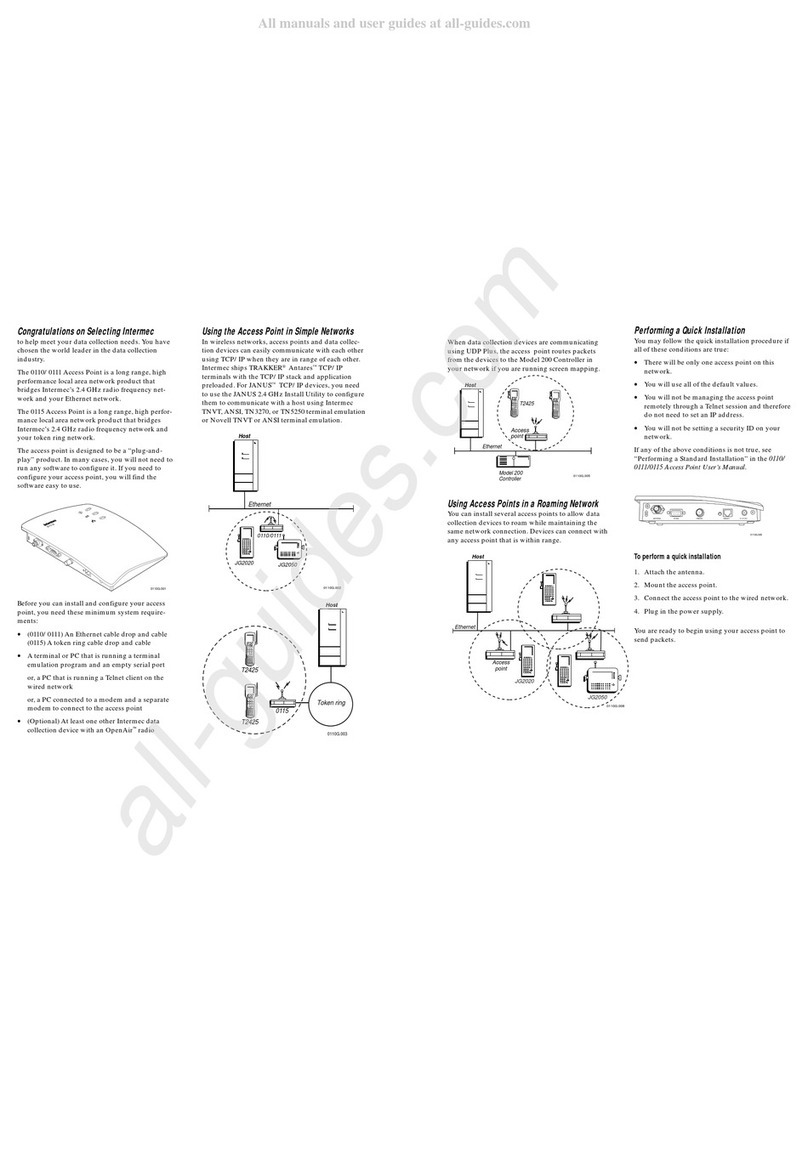
Intermec
Intermec 0110 Getting started guide
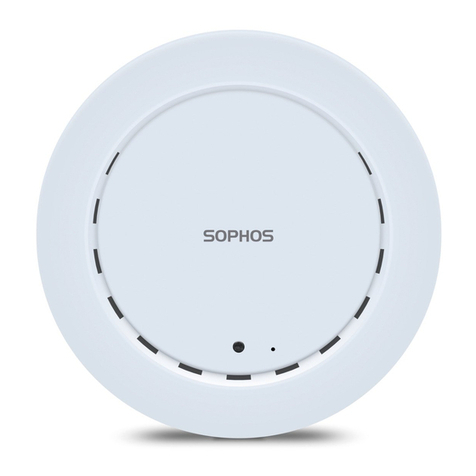
Sophos
Sophos AP 55C Technical specification
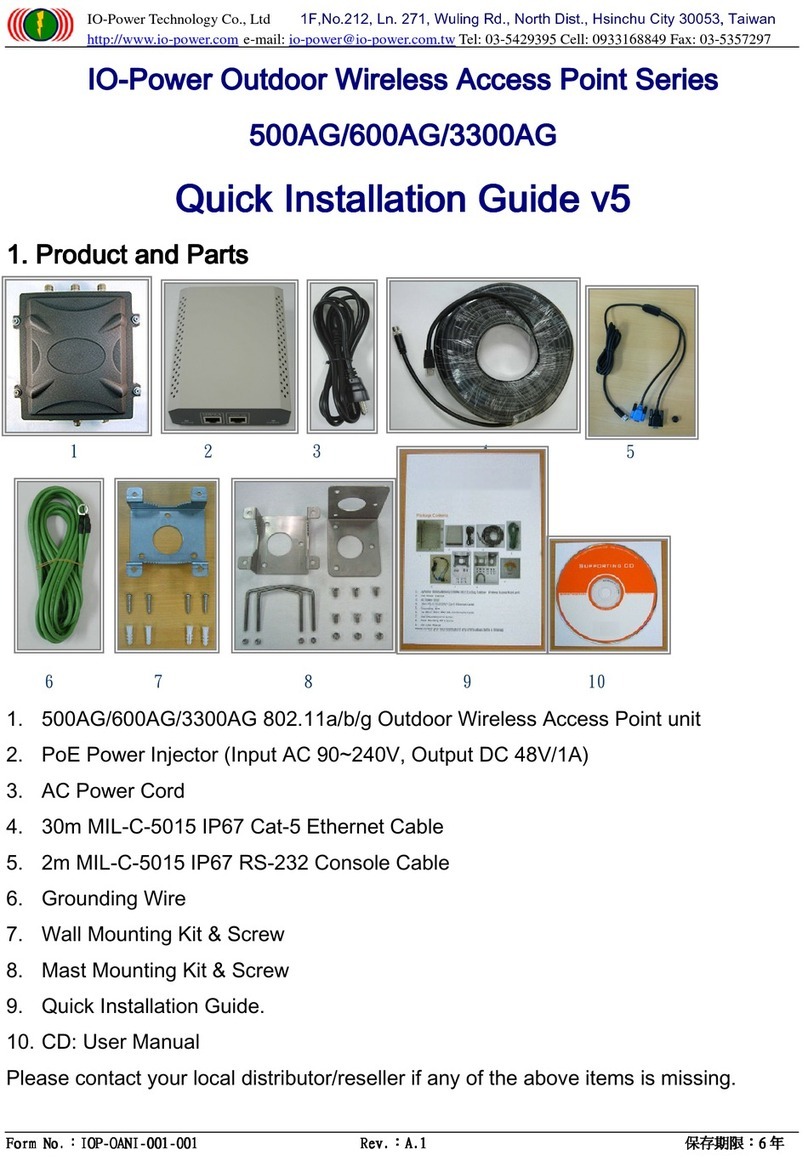
IO-Power Technology
IO-Power Technology 500AG SERIES Quick installation guide

H3C
H3C WA510H installation guide
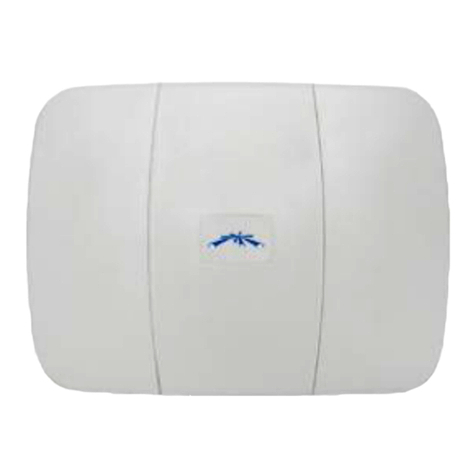
Ubiquiti
Ubiquiti PowerStation2 user guide
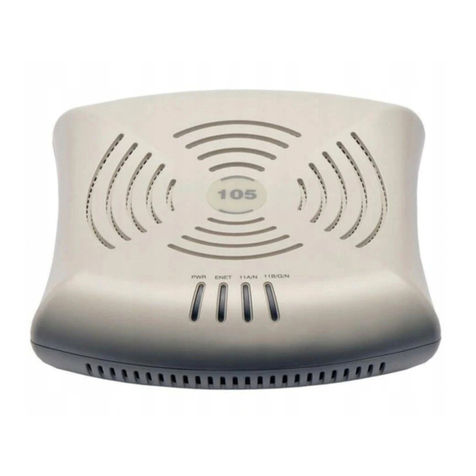
Aruba
Aruba AP-105 installation guide
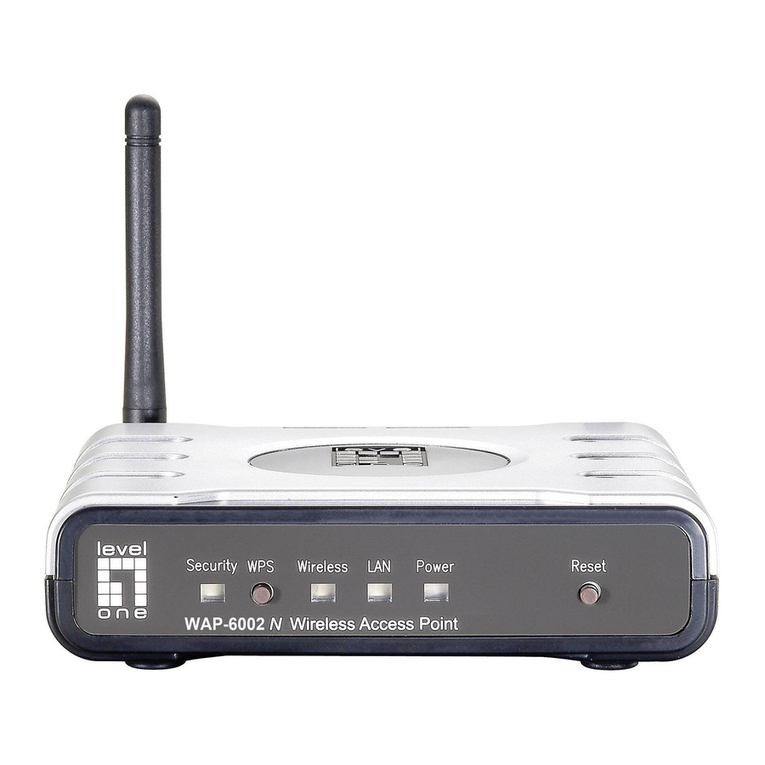
LevelOne
LevelOne WAP-6002 Quick installation guide
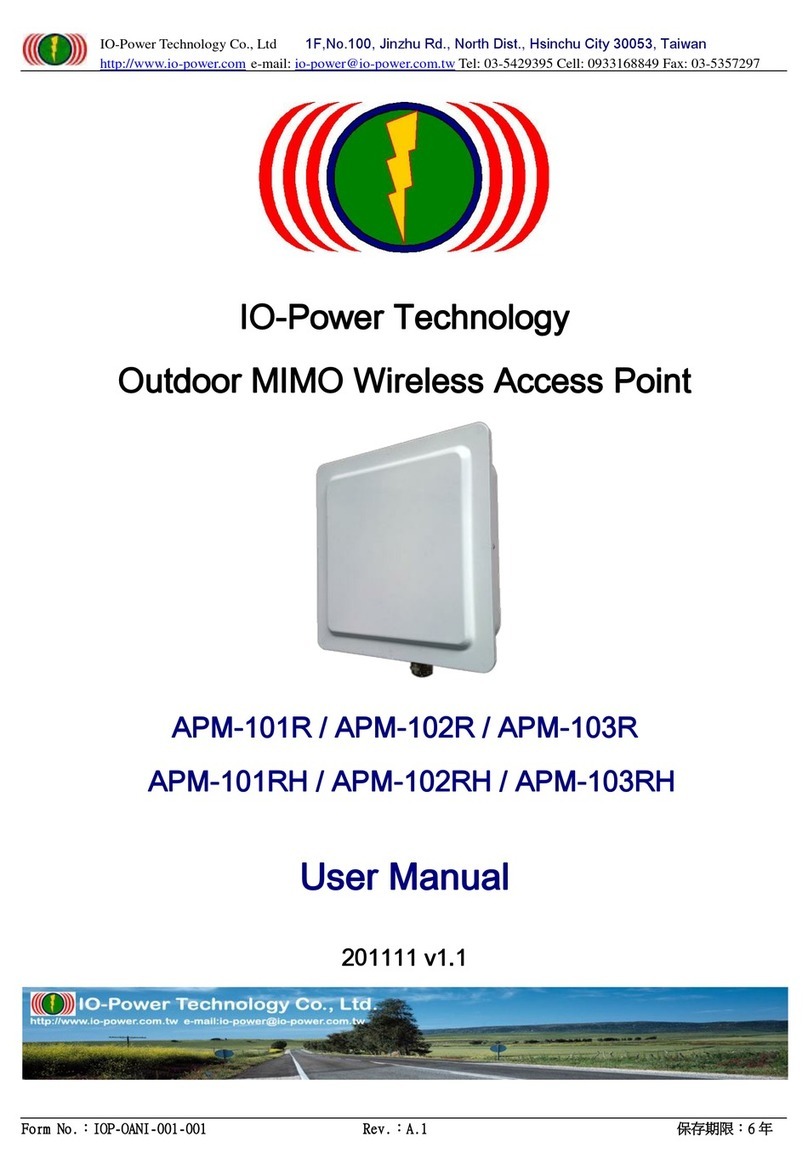
IO-Power
IO-Power APM-101R user manual
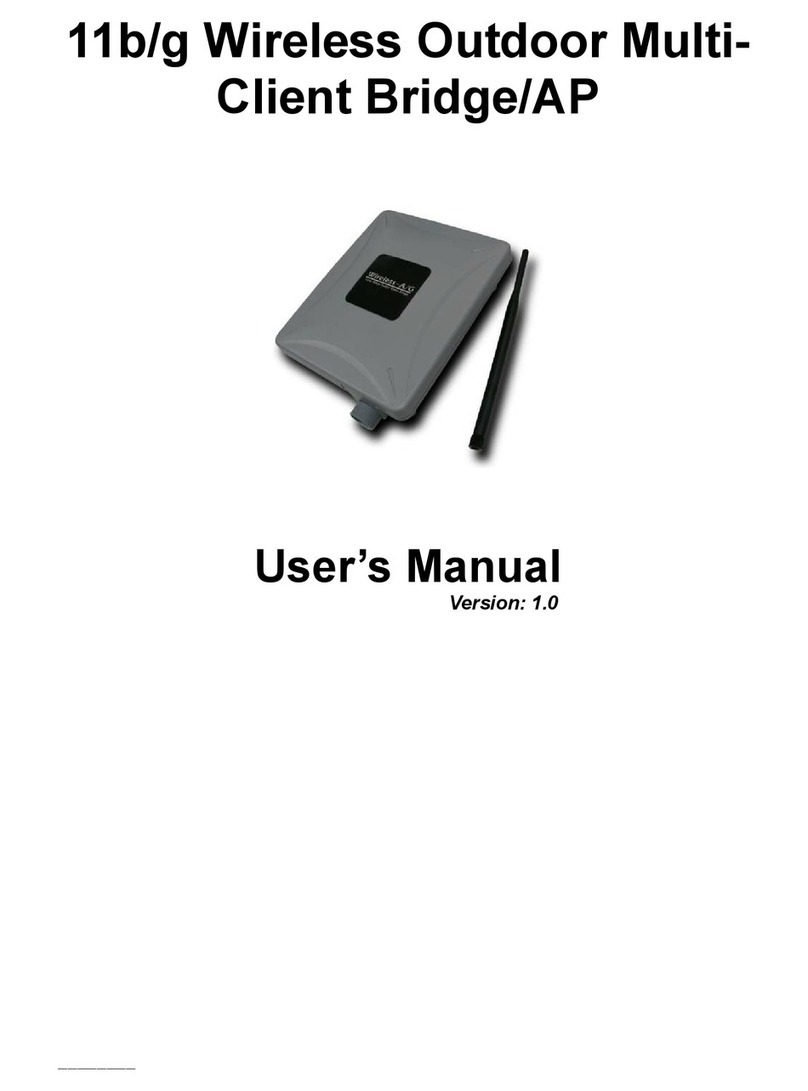
EnGenius
EnGenius 11b/g Wireless Outdoor Multi-Client... user manual
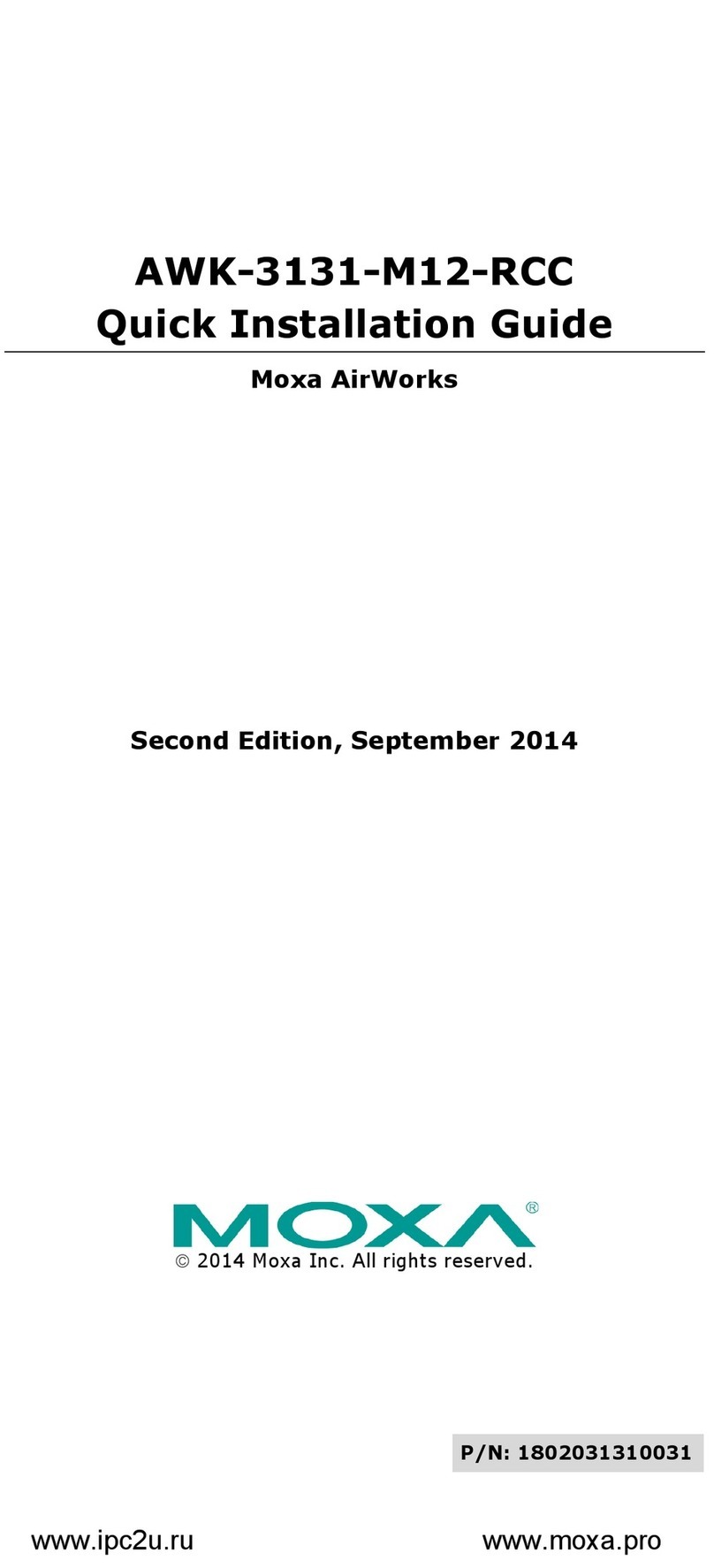
Moxa Technologies
Moxa Technologies AirWorks AWK-3131-M12-RCC Quick installation guide
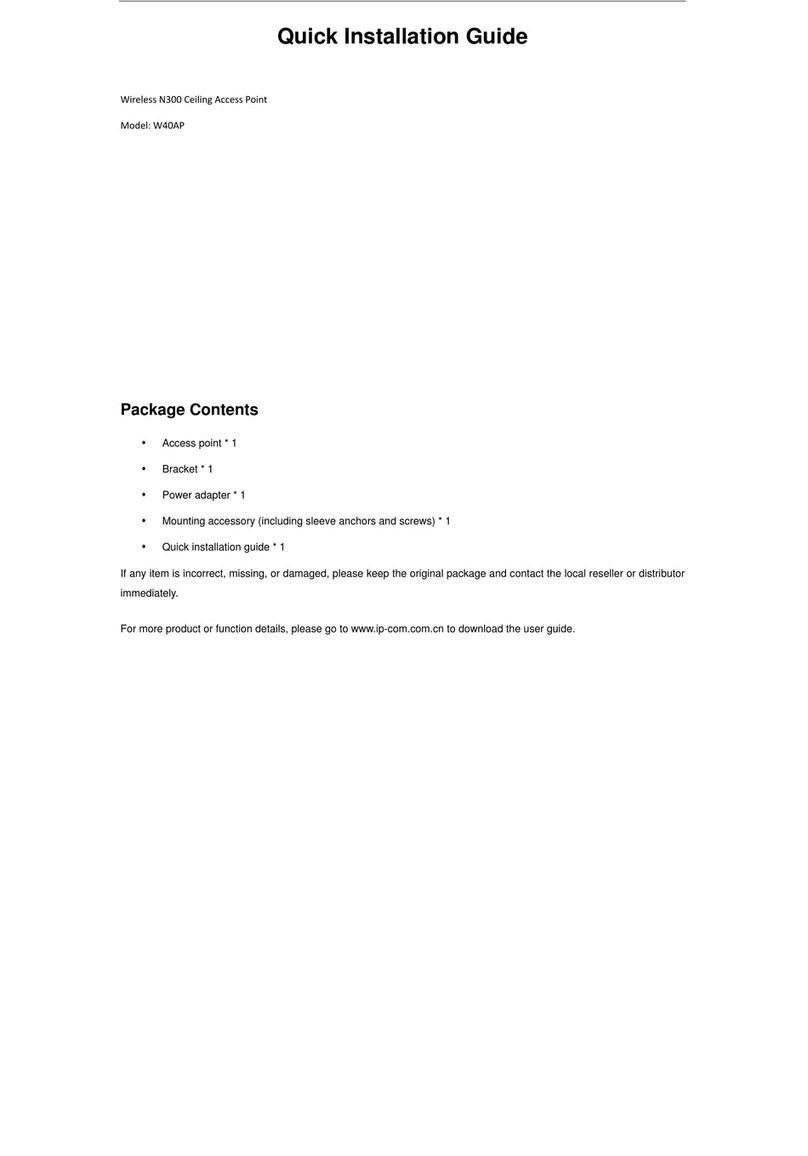
IP-COM
IP-COM W40AP Quick installation guide
